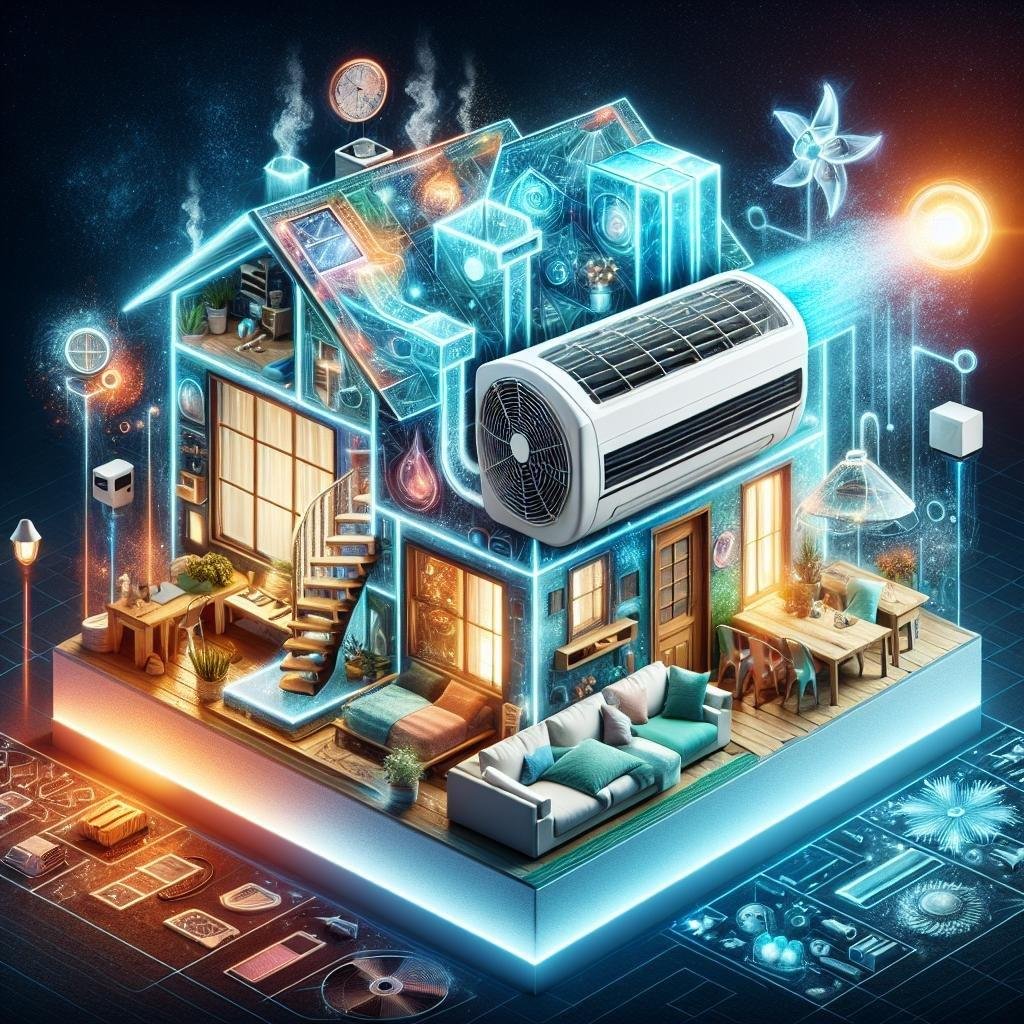Welcome to a cooler, more efficient way of zoning your home with a mini split AC system! If you’re tired of battling over the thermostat or struggling with certain rooms being too hot or too cold, then you’re in the right place. In this article, we’ll guide you through everything you need to know about optimizing your home’s comfort and energy usage with a mini split AC system. Let’s dive in and unlock the key to a perfectly zoned home environment!
Choosing the Perfect Mini Split System for Your Space
Selecting the right mini split system for your space hinges on a few pivotal factors. First and foremost, consider the **size of the area** you need to cool or heat. A unit that’s too small will struggle to maintain comfort, while an oversized system may short-cycle, impacting efficiency. **BTU (British Thermal Unit) capacity** is your guiding star here. For example, a 300 square foot room typically requires a 7,000 BTU system. Don’t forget to factor in the **insulation quality**, **ceiling height**, and the number of windows, as these elements can influence your unit’s performance. Employing a professional for load calculation can remove much of the guesswork.
Next, contemplate the **system’s energy efficiency** by reviewing its **SEER (Seasonal Energy Efficiency Ratio)** rating. Higher SEER ratings mean better efficiency and lower energy costs. Look for systems with **inverter technology**, which dynamically adjusts the compressor speed rather than mere on-off cycling, ensuring maximum comfort and efficiency. **Additional features** like **Wi-Fi control**, **programmable settings**, and **integrated air purifiers** can further enhance your overall experience. Below is a comparison table that highlights some top choices of mini split systems:
| Brand | BTU Capacity | SEER Rating | Special Features |
|---|---|---|---|
| Mitsubishi | 9,000 | 26 | Wi-Fi Control, Air Purifier |
| Daikin | 12,000 | 22 | Inverter Tech, Quiet Operation |
| Fujitsu | 18,000 | 21 | Energy Star, Programmable Settings |

Designing Your Home’s Climate Zones for Maximum Comfort
Strategically assigning climate zones within your home can transform your living experience into a cocoon of comfort. With a **mini split AC system**, individualizing temperature control becomes an art form, allowing each room to cater to its unique requirements. The overall goal is to divide your house into different zones that reflect how and when each space is used. Imagine a relaxing evening in the living room with a cooling breeze, while your home office maintains a steady, focused warmth. This intelligent customization doesn’t only boost comfort but also enhances energy efficiency, creating a harmonious blend of technology and living.
When configuring your home’s zones, consider the following:
- Usage Patterns: Tailor each zone’s climate based on the room’s function and usage frequency.
- Sun Exposure: Adjust for rooms that receive more sunlight, requiring different temperature settings.
- Family Preferences: Take into account individual comfort levels, making sure everyone is happy.
| Room | Recommended Setting |
|---|---|
| Living Room | 22-24°C (72-75°F) |
| Home Office | 21°C (70°F) |
| Bedroom | 18-20°C (64-68°F) |
By giving thoughtful attention to these zones, you can sculpt an environment where comfort meets efficiency, proving that the right zoning can indeed make a house feel more like a home.

Installation Tips and Tricks for Optimal Efficiency
For achieving the highest energy efficiency and comfort with your mini split AC system, consider the following tips:
- **Proper Placement**: Install indoor units high on the walls in the spaces you frequent the most. This allows the cool air to circulate better and ensures more even cooling throughout the room.
- **Clear Surroundings**: Ensure that both indoor and outdoor units are free from obstructions. Blockages can cause the system to overwork, leading to higher energy consumption and reduced lifespan.
| Location | Reason |
|---|---|
| Living Room Wall | Central gathering point, needs even cooling. |
| Outdoor, Shade | Prevents overheating, improves efficiency. |
| Bedroom Ceiling | Maximizes floor space, uniform cooling. |
Maintenance is just as critical after installation:
- **Regular Cleaning**: Clean your filters at least once a month to avoid clogs and ensure optimal airflow.
- **Seasonal Inspection**: Before peak cooling and heating seasons, have your system inspected to guarantee it’s operating at its best.
- **Smart Controls**: Invest in a smart thermostat compatible with your mini split system to better manage your home’s climate and reduce energy consumption.
Following these tips not only ensures efficient zoning but also prolongs the lifespan of your mini split AC system.

Maintaining and Troubleshooting Your Mini Split AC System
Keeping your mini split AC system in peak condition requires regular attention to maintain optimal performance. To start, ensure the **filters** are clean by checking them every month. Dust and debris can accumulate quickly, reducing efficiency and air quality. For easy filter cleaning, follow these steps:
- Turn off the unit
- Remove the front panel
- Gently wash the filter with mild soap and water
- Allow it to dry completely before reinstalling
Besides filters, the **outdoor unit** needs periodic care. Keep it free of leaves, dirt, and other obstructions to ensure unobstructed airflow. Trim any nearby plants and regularly rinse the unit with a garden hose (on a low setting) to remove accumulated dust and grime.
Even with diligent maintenance, issues may arise. Common troubleshooting tips include:
- **Strange noises**: Could indicate loose components or debris in the blower fan. Inspect and tighten as needed.
- **Insufficient cooling**: May be due to a blocked air filter, low refrigerant levels, or a malfunctioning thermostat.
- **Water leakage**: Often a result of a clogged condensate drain. Regular cleaning can prevent this issue.
| Issue | Possible Cause | Solution |
|---|---|---|
| Strange Noises | Loose parts or debris | Inspect and tighten |
| Insufficient Cooling | Blocked filter or low refrigerant | Clean filter, check refrigerant |
| Water Leakage | Clogged drain | Clean condensate drain |
Q&A
Q&A: Efficiently Zoning Your Home with a Mini Split AC System: What You Need to Know
Q: What exactly is a mini split AC system, and why should I consider it for my home?
A: Great question! A mini split AC system is a type of heating and cooling solution that consists of an outdoor unit and one or more indoor units. Unlike traditional HVAC systems, mini splits don’t require extensive ductwork. They offer a flexible, efficient way to control the climate in individual rooms or zones of your home. Think of it as targeted climate control, allowing you to enjoy personalized comfort in every corner of your home while saving on energy bills!
Q: How is zoning with a mini split AC system different from a traditional central air system?
A: Ah, the beauty of zoning! With a traditional central air system, your entire home is generally cooled (or heated) to the same temperature, which can lead to wasted energy. In contrast, mini splits allow you to create independent temperature zones in different rooms. This means you can cool the bedroom while keeping the kitchen warm, or vice versa, without compromising comfort in other areas. It’s like having a custom climate plan for each room!
Q: Can any home be zoned using mini splits, or are there specific requirements?
A: Mini splits are remarkably adaptable and can be installed in a wide variety of homes, from modern builds to charming older houses. There are no strict requirements, but the layout of your home can influence the design of your mini split system. For example, homes with open floor plans might need fewer zones compared to homes with many separate rooms. Your HVAC professional can help determine the best configuration for maximum efficiency and comfort.
Q: What are some of the benefits of using mini splits for zoning?
A: So many benefits! Here are a few highlights:
- Energy Efficiency: Only heat or cool the rooms you’re using, significantly reducing energy usage.
- Personalized Comfort: Everyone gets their preferred temperature in their own spaces—no more thermostat wars!
- Quiet Operation: Mini splits are known for their quiet performance, providing a peaceful indoor environment.
- Flexible Installation: They can be mounted on walls, ceilings, or even floors, offering versatile solutions for any room.
- Improved Air Quality: Advanced filtration systems can enhance your indoor air quality by eliminating pollutants.
Q: Do mini split systems require a lot of maintenance?
A: Not at all! Mini splits are designed to be low-maintenance. Regular cleaning of the filters, occasional professional servicing, and ensuring the outdoor unit is free from debris are typically all that’s needed. These simple steps will keep your system running efficiently and extend its lifespan.
Q: How does the cost of installing a mini split system compare to other HVAC options?
A: Initially, the cost of a mini split system might seem higher than a traditional HVAC system, especially if you’re installing multiple indoor units. However, the savings on your energy bills and the increased efficiency typically offset this initial investment in the long run. Plus, the tailored comfort and flexibility you get is hard to beat!
Q: Any tips for making the most out of a mini split zoning system?
A: Absolutely! Here are a few expert tips:
- Strategic Placement: Place units in areas where you spend the most time. For example, a unit in the living room and the bedrooms will provide excellent coverage.
- Insulation: Ensure your home is well-insulated to maximize the efficiency of your mini split system.
- Smart Controls: Invest in programmable or smart thermostats to easily manage your zones and schedules.
- Regular Maintenance: Keep up with regular maintenance to ensure optimal performance and longevity.
Q: Is a mini split system a good option for my home’s needs?
A: If you crave flexibility, personalized comfort, and energy efficiency, then absolutely! A mini split system can be tailored to meet the specific needs of your home and lifestyle. Whether you want to create a cozy reading nook that’s always at the perfect temperature or an energy-efficient climate solution for your entire home, a mini split system could be your new best friend in home comfort.
With these insights, you’re now armed with the knowledge to consider if a mini split AC system is the right fit for efficiently zoning your home. Happy zoning and stay cool!
Wrapping Up
As you embark on your journey to transform your living space into a haven of comfort and efficiency with a mini split AC system, remember that the heart of your home thrives in the delicate balance of tailored zones and whisper-quiet comfort. By mastering the art of zoning, you’re not just controlling the temperature; you’re crafting a symphony of solace, a ballet of breezes that dance through your rooms with elegance and precision.
Whether you’re curling up with a book in your perfectly chilled reading nook, hosting friends in a living room that adapts to the rise and fall of laughter, or creating a serene bedtime retreat, your mini split AC system is the silent conductor ensuring every moment is just right. So breathe easy and embrace the seamless comfort, knowing every degree of your home is tempered with care.
Thank you for joining us on this exploration of efficient home zoning. Here’s to climates perfected, spaces cherished, and the boundless joys of living in harmony with your surroundings. Stay cool, stay cozy, and until next time—happy zoning!

